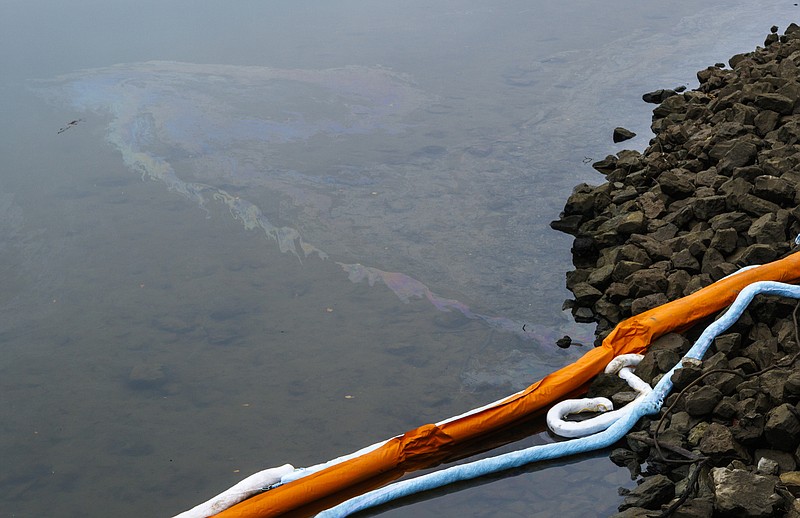It seems we've hardly been able to pick up the paper in recent days without reading about chemical pollution.
On Saturday, a front page story by The Associated Press notes that 2 million people - including some in Chattanooga - live within a mile of 327 Superfund sites in areas prone to flooding or vulnerable to sea-level rise caused by climate change, according to an AP analysis of flood zone maps, census data and U.S. Environmental Protection Agency records.
You may recall that this became a very real issue last year when rains from Hurricane Harvey swamped more than a dozen Superfund sites in Houston, breaching two of them. Similar problems were reported in Puerto Rico after Hurricane Maria.
But serious chemical pollution doesn't take a hurricane - or a Superfund site.
We were reminded of this today and Tuesday with headlines about a chemical spill in Citico Creek just upstream from the river intakes that feed Chattanooga's drinking water system.
Officials said "well in excess" of 1,000 gallons of petroleum spilled into the creek Monday evening.
A little bit of pollution can go a long way in water - especially some chemical pollution.
In 2014, 300,000 residents in nine counties near Charleston, W. Va., were forced to go without running water for days and weeks after 5,000 to 7,000 gallons of a solvent-based industrial chemical used in coal processing seeped from a ruptured storage tank into the Elk River, just upstream of the intake pipes for Charleston's regional water company.
At the first announcement of the Charleston spill, Gary Southern, the president of Freedom Industries which owned the ruptured tank, told residents and reporters that the pollutant was a "very low toxicity" chemical. But when West Virginia American Water saw that its carbon filtration system could no longer handle the large amount of contamination in the water - in other words the chemical began flowing through the carbon filter even with more carbon added - the company leaders concluded the water was unsafe for use and instructed customers not to drink, cook with, bathe or wash with their tap water.
The West Virginia Department of Health and Human Resources reported that within five days of the spill, nearly 700 residents had contacted West Virginia's poison control center, reporting a range of symptoms including nausea and rashes. Fourteen were hospitalized.
Charleston area businesses closed, schools in eight counties closed, hospitals took emergency measures to conserve water, the West Virginia Legislature was forced to cancel sessions, as were the West Virginia Supreme Court of Appeals in Charleston and the courts in Boone and Lincoln counties. The West Virginia State University Institute also cancelled classes. The city cancelled a convention of mayors and city council members from around the state.
Freedom Industries filed bankruptcy. Lawsuits are still pending against the water company and Eastman chemical company, the chemical's manufacturer.
Chattanooga has been far more fortunate, but the point is chemical pollution can be a very serious matter.
Locally, Chattanooga Creek, also a Superfund site in some of its six or seven miles that flows through the industrial heart of Chattanooga, sits in a flood plain that becomes marsh-like at least once a year. There we weren't talking about a little pollution, but a lot. During World War years and before America had environmental laws, a company that burned coal 24-hours a day to make the hot-burning coke to melt iron for war-effort steelmaking literally ditched millions of gallons of its by-product - liquid coal tar - into the creek and the wetlands around it.
Decades later, two miles of the creekbed became a multi-year national priority list Superfund site. When additional pollution - a creosote-like material believed to have come from a then-defunct wood preservation company - was found, some of the clean-up fixes became first-ever-tried experiments because the pollution continued to flow through or over the liner and into the creek. Even now, the fix is threatened when a storm far short of hurricane force topples a tree with roots in the liner beds.
Now EPA has just given us notification that it will add another local site to the list of the country's most toxic places - this one is a new kind of threat in several local residential areas:
The Southside Chattanooga Lead Site is one of 10 sites across the country recommended to be added to the Superfund Program's National Priorities List.
"The priority for proposing the site is protecting children by identifying and cleaning up lead-contaminated soil," according to a release from the EPA.
In Chattanooga's growth times over past centuries and decades, fill or top soil was added to raise land on building sites in Alton Park, Cowart Place, Jefferson Heights, Richmond and the Southside Gardens. That fill apparently came from our many early smelting industries and was contaminated with lead levels that continue to register above health-based benchmarks. The problem was discovered in 2011 and regulators began a lead sampling and removal effort in 2012.
It all just goes to show: We cannot be too careful about pollution.
